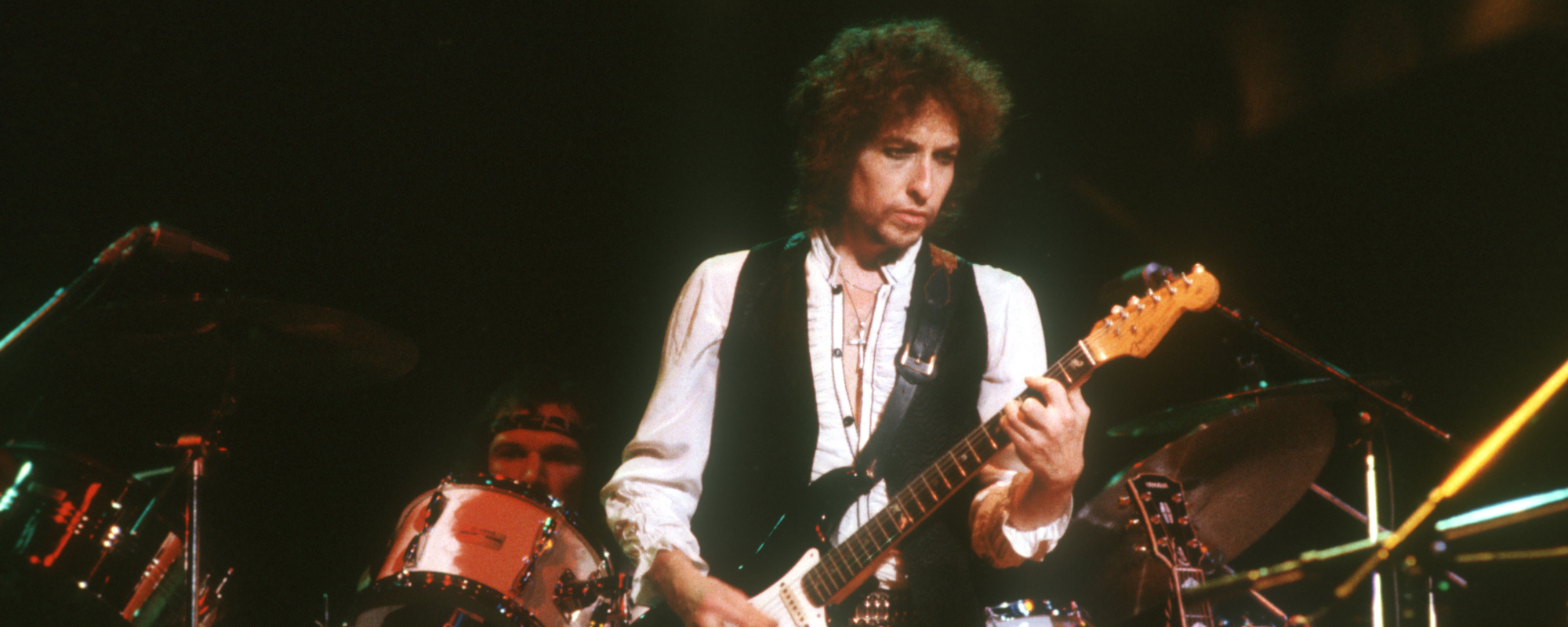Bob Dylan has worn many masks in his 82 years. He’s a serial fabulist who invented his origin story and his name. Dylan’s 2004 memoir Chronicles: Volume One is full of characters and stories that each hold various versions of truth and untruth. Dylan is feisty and elusive and even with a memoir you get the feeling he’s keeping some cards to himself.
Videos by American Songwriter
Because of that and because of Dylan’s greatness, a favorite pastime is trying to dissect what his songs mean. Arguably the greatest American songwriter, Dylan is a mischievous and erudite poet who directs listeners like a lit-obsessed musicologist.
“A Hard Rain’s A-Gonna Fall” is a revelation song. It’s a beat-poet psalm with an end-of-times warning. The possibility of nuclear war in the 1960s had the world on edge and Dylan skips the cause to focus on the symptom.
Dylan worked through the anxiety of the Cold War by writing a long poem on his typewriter. “A Hard Rain’s A-Gonna Fall” was recorded in one take in 1962 and appeared on Dylan’s second album, The Freewheelin’ Bob Dylan.
“A Hard Rain’s A-Gonna Fall” explores human suffering using imagery and symbolism to warn of looming tragedy. With the release of Freewheelin’ in 1963, Dylan became the torch-bearer of his generation. It’s the sound of Dylan riding an early crest of a wave to the height of his powers.
Upon hearing The Freewheelin’ Bob Dylan, the poets of New York City witnessed the student becoming the master.
The Meaning Behind the Song
“A Hard Rain’s A-Gonna Fall” started as a poem. Dylan thought he had several songs within that poem but instead chose to write only one. In 1962, the world was on edge during the Cuban Missile Crisis—the 13-day standoff between the United States and the Soviet Union. The U.S. government had nuclear weapons stationed in Italy and Turkey. The Soviet Union responded by placing nuclear weapons in Cuba. Who would blink first?
The CIA was engaged in efforts to overthrow the Castro regime in Cuba. Fidel Castro convinced Nikita Khrushchev, the first secretary of the Communist Party of the Soviet Union, to place nuclear missiles in Cuba to deter any more actions from the Americans.
I’ll walk to the depths of the deepest dark forest
Where the people are many and their hands are all empty
Where the pellets of poison are flooding their waters
Where their home in the valley meets the damp dirty prison
In Chronicles: Volume One, Dylan says about the song, “It’s all one long funeral song.” But can we take Dylan at his word? If you’ve paid attention to Dylan’s life, the answer is no.
The song was written prior to the Cuban Missile Crisis and it could reflect a general feeling of bleakness. The rain mustn’t be interpreted as fall-out from nuclear weapons, but rather a metaphor for an ending of some kind. The 1960s was a decade full of turmoil and schism.
It represents a feeling of hopelessness. Beat poet Allen Ginsberg famously wept the first time he heard the song.
And it’s a hard, it’s a hard
It’s a hard, and it’s a hard
It’s a hard rain’s a-gonna fall
Dylan, still heavy in his Woody Guthrie phase, doesn’t sound resigned to the end—his eyes are wide open. He’s not so much a poet preaching as he is someone putting words to what many people were feeling about the world during this tumultuous period.
The writer
Bob Dylan wrote “A Hard Rain’s A-Gonna Fall” in New York City in 1962. Written on a typewriter, an early draft showing revisions and alternate lyrics was auctioned at Sotheby’s for $485,000.
Journalist Nat Hentoff wrote in the liner notes to The Freewheelin’ Bob Dylan that the general mood of the country during the Cold War had an effect on Dylan, and the specific events of the Cuban Missile Crisis may or may not have inspired him to write “A Hard Rain.”
About the Song
The Freewheelin’ Bob Dylan was released in May 1963. The album opens with “Blowin’ in the Wind.” Three songs in we hear “Masters of War.” “A Hard Rain’s A-Gonna Fall” is followed by “Don’t Think Twice, It’s All Right.” Dylan’s second album was a giant shift in popular culture.
“A Hard Rain’s A-Gonna Fall” is a defining song for Dylan, a reluctant orator for his generation. He was like a sphinx—a man full of riddles with an audience expecting answers.
With “A Hard Rain,” Dylan voiced the general anxiety of Cold War doom in America.
I met a young child beside a dead pony
I met a white man who walked a black dog
I met a young woman, her body was burning
I met a young girl, she gave me a rainbow
Dylan is a man who’s seen the ending. “A Hard Rain’s A-Gonna Fall” is his revelation.
Having an impact
When Bob Dylan released The Freewheelin’ Bob Dylan, the folk-hero torch had been passed. “A Hard Rain’s A-Gonna Fall” defined Bob Dylan. He was no longer Woodie Guthrie’s disciple. Dylan’s voice was too big, too self-assured to live in anyone’s shadow. Freewheelin’ changed the beat scene in New York. It would soon change the world.
Conclusion
“A Hard Rain” is Dylan reporting the news of the world. But he’s more than just a journalist. He’s a sage, arranging words around wisdom and he’s here to tell everyone how this is all going to end. There’s safety in certainty.
This is where he became a prophet. Bob Dylan used a lifetime of myths to write the greatest songbook in history.
Photo by Fin Costello/Redferns












Leave a Reply
Only members can comment. Become a member. Already a member? Log in.